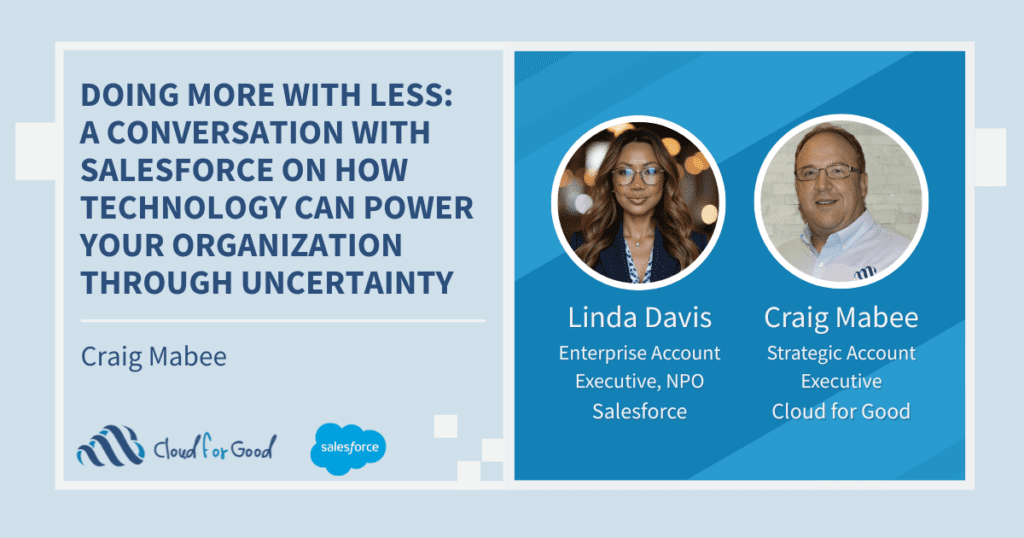You just signed off on a Salesforce implementation project, and you’re about to schedule your kick-off call with your consultant. When you sit down to look at your calendar, you wonder, “who else on my team will be participating in this process?”
Here at Cloud for Good, we want to hear from everybody – from the person answering the phones to the executive stakeholders, and everyone in between. Your Salesforce project is going to affect the work habits, performance, and day-to-day life of many individuals, so it’s imperative that their knowledge and input is reflected throughout the process. So, where do you start?
The Key Players
Project Manager
Hiring an implementation consultant can certainly make the job of implementing Salesforce easier, but there is still a lot of work to be done. You’ll first want to select a someone from your organization who can be project manager. This individual will be the main point of contact with the Salesforce implementation consultant and will be responsible for coordinating and communicating with both the implementation consultant as well as the internal team. The project manager should be prepared to take part in a number of meetings, and generally be available throughout the duration of the project. This individual can be someone from any team, including program managers, development officers, or operations directors. More important than the title is the individual’s ability to connect and communicate with all internal stakeholders, their authority to sign off on various project milestones, and their availability.
Salesforce Administrator
Once the project is completed and you are using Salesforce, someone at your organization will be responsible for maintaining your data, helping users with any questions, and updating as necessary – This is your Salesforce Administrator. The earlier this person can be involved, the better results you will have. If you are transitioning off of another database, the previous database administrator or IT specialist will often take on this role. Incorporating their input will be critical to the success of this project, and it’s a great idea to have them join the project manager for as many meeting as possible. If your future Salesforce Administrator is brand new to Salesforce, you can have them ramp up for the role by sending them to explore Trailhead, a free and fun online training platform from Salesforce.
Executive Stakeholders
At Cloud for Good, we think that everyone at your organization is a VIP. But in the context of your Salesforce implementation project, Executive VIPs will be the individuals who ask for regular reports, numbers, contact information – all of which will be much easier to gather once you have a well-configured Salesforce instance. While they may not have the time to fully participate in the project, make sure to ask them what data or reports they would like to see on a regular basis. It is also helpful to make sure your Executive Stakeholders are the biggest supporters of your Salesforce implementation project to help drive adaptation.
Other Staff
Every nonprofit is different, and not everyone will have the same departments in their organizational makeup. The most important consideration here is that every department reflected in your statement of work is reflected in this process. Is your project focused on improving fundraising processes? Make sure your development team is involved. Is your project focused on better retention and reporting of programmatic information? Invite your program team to take part. Does your project involve streamlining your email marketing campaigns? Call up the marketing team! Trying to clean up a messy events registration process? Welcome to the party, events team!
Let’s Talk Numbers
Once you decide what departments should be involved, you may still have some questions. Your development team is made up of fifteen employees, should they all plan to clear their calendars? The answer is…yes…and no. Beyond the logistical challenges involved in coordinating meetings between fifteen people, balancing differences of opinion and the sheer number voices n the room may make for unproductive meetings. Instead, teams should try to set some time aside to consolidate opinions, questions and feedback so that they can best be addressed by your implementation partner.
Don’t Know Where to Start?
Think about what you love and hate about your current systems, what data and reports you need on a regular basis, and what Salesforce would ideally be able to do for you by the end of the project. Elect a key point person to represent your team, and have them communicate directly with the internal project manager. In this way, you can have less people directly involved with the project, while still ensuring that the interests of as many stakeholders as possible are represented.
It’s Worth it
Remember that your consultants are here to help. At Cloud for Good, we want to hear what you have to say so we can best help you improve your business processes and analytics. Even when it feels frustrating to think through these processes, wade through clogged systems, and dig through disorganized data, remember that your hard work is going to leave you with a more efficient and easy-to-use system. By ensuring that everyone in your organization has a voice at the table from the very beginning, you’re significantly more likely to avoid unpleasant surprises once you’re up and running, and also more likely to be happy with your end results!
You may also enjoy reading:





